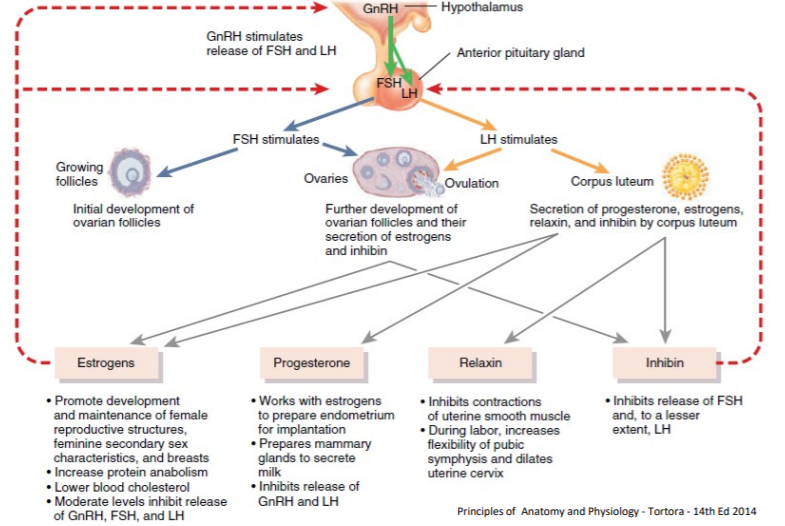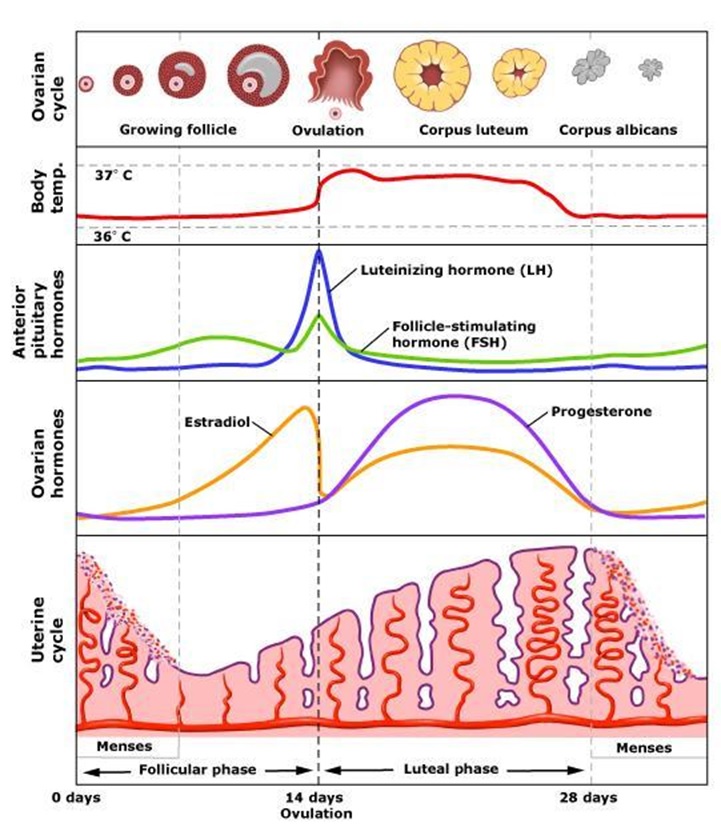 We all know the highs and lows of being a woman (assuming you, the reader, are a woman of course), and we tend to have a general idea of what our body feels like as we go through our monthly cycle. But it is rare that women know intricacies our body upholds that allows us to menstruate, purge and create life.
We all know the highs and lows of being a woman (assuming you, the reader, are a woman of course), and we tend to have a general idea of what our body feels like as we go through our monthly cycle. But it is rare that women know intricacies our body upholds that allows us to menstruate, purge and create life.
We may know a thing or two about hormones, but to appreciate how things can go wrong, we need to make sure we have a firm grasp on how our cycle is meant to unfold in the first place. So let’s take a closer look at what ha[[ens during our cycle.
An average menstrual cycle lasts about 28 days, with the period happening in the first (usually) 5 days and ovulation occurring around day 14. Of course, everyone is different, and a cycle can vary in healthy and unhealthy ways.
Apart from these well-known stages, the menstrual cycle is divided into 4 phases: the menstrual phase, the follicular phase, the ovulation phase, and the luteal phase:
The Menstrual Phase:
This happens when an egg from the previous cycle has not been fertilized and the thickened uterus lining dispels through the vagina as it is no longer needed. A combination of blood, mucus, and tissue is shed generally over the space of 3-7 days. This all occurs because when the woman does not get pregnant and the body has a need to shed the lining, levels of the hormone’s oestrogen and progesterone drop, causing the onset of the period.
The Follicular Phase:
This phase overlaps with the menstrual phase as it starts on the first day of the period and ends on the day of ovulation. Tending to last around 16 days, the follicular phase is an important stimulant stage. It starts when the hypothalamus signals the pituitary gland to release a hormone called Follicle Stimulating Hormone (FSH).
FSH, in turn, stimulates the ovaries to release anywhere between 5-20 tiny sacs called follicles, each one containing an immature egg. Most of these follicles get reabsorbed by the body, but the healthiest one survives and begins to announce its arrival to the party by recruiting a score of oestrogen to begin thickening the walls of the uterus ready for its grand entrance.
The Ovulation Phase:
The entrance we’ve all been waiting for. Well more the release actually. In this phase, the pick of the immature eggs has had a chance to mature, and now is being released by the ovaries and into the fallopian tube. This is made possible by the rising levels of oestrogen in the follicular phase which stimulates the pituitary gland yet again, this time releasing Luteinizing Hormone (LH), which starts the whole process off. So, the mature egg is now heading down the fallopian tube, probably envisioning itself on a red carpet for all we know, ready to be fertilized by the sperm.
This is the phase in which women can get pregnant and there are a couple of signs to tell when a woman is ovulating. The main indicators are a slight rise in basal body temperature (body temperature when fully at rest), and thicker discharge (almost like egg white consistency).
More specifically – a few days before ovulation, you may notice your vaginal mucus becomes clear, slick and slippery, and feels a bit like egg white. This is a sign that ovulation is about to happen. It’s the best time to have sex, as sperm travel more easily in this kind of mucus.
This phase lasts about 14 days and consists of the follicle that has released its egg changing into the corpus luteum, which is essential for conception to occur and pregnancy to last.
The corpus luteum releases hormones, mostly progesterone and a bit of oestrogen, which keeps the cushioning of the uterus nice and thick, ready for the egg to come and implant if fertilized. If this does happen, the hormone Human Chorionic Gonadotropin (hCG) is produced. hCG helps to maintain the corpus luteum and uterine lining, as well as being the hormone that pregnancy tests pick up.
If the egg is not fertilized and pregnancy does not occur, the corpus luteum will be reabsorbed, decreasing levels of oestrogen and progesterone and bringing us back to day one. This phase when not pregnant also gives us the classic symptoms of breast swelling, blooding, mood swings, and food cravings that we love to refer to as PMS, ah the joys.
For further information and description of each hormone and its function and levels throughout the cycle, check out these diagrams below.

 Now, not all women will have wonderfully regular periods, only 10-15% have a 28-day cycle. Some last longer or not as long, some are heavier or lighter, some are irregular, and others just have a mind of their own. Irregularities are the most common in the time just after getting your first period during puberty. Make sure you read our blog Periods: Is What You’re Feeling Normal?for an eye-opening look at what’s considered normal with blood flow, colour and volume.
Now, not all women will have wonderfully regular periods, only 10-15% have a 28-day cycle. Some last longer or not as long, some are heavier or lighter, some are irregular, and others just have a mind of their own. Irregularities are the most common in the time just after getting your first period during puberty. Make sure you read our blog Periods: Is What You’re Feeling Normal?for an eye-opening look at what’s considered normal with blood flow, colour and volume.
There are a few things to be wary of, however.
- If you skip periods or they stop altogether,
- if they’re insanely irregular,
- if bleeding lasts for more than 7 days, (yes you read that correctly)
- if there is bleeding in between periods that is heavier than just spotting,
- or if your cycle lasts less than 21 days,
- or if your cycle lasts more than 35 days,
- dark brown blood,
- think, gluggy blood or heavy clotting
We discuss what each of these changes may mean in “Periods: Is what your feeling normal?“
As much as it doesn’t feel like it at times, and sometimes we curse the way our anatomy ruins a nice pair of white jeans or it flaws us for a day or two, our cycles are a necessary and beautiful gift.
Aside from pregnancy and breastfeeding, of course, there are a few things that appear to disrupt our cycle, one of the biggest culprits nowadays is birth control, please look at our blog How the Pill and Other Contraceptives Impact Your Health to further educate yourself on the potential ramifications of this widely used meddler. Don’t worry we also explore safer contraceptive alternatives.
There are some health conditions that can affect our periods and cycles such as:
Polycystic ovary syndrome (PCOS): which prevents an egg from developing normally, thus causing irregular cycles and missed periods
Uterine fibroids: are noncancerous growths in the uterus that can make periods longer and heavier than usual
Eating disorders (anorexia, bulimia etc.): can all disrupt the menstrual cycle and make our periods stop altogether.
Premature ovarian failure: Premature ovarian failure refers to the loss of normal ovarian function before age 40. Women who have premature ovarian failure — also known as primary ovarian insufficiency — might have irregular or occasional periods for years.
Pelvic inflammatory disease (PID): This infection of the reproductive organs can cause irregular menstrual bleeding.
Irregularities can be quite common in cycle length, weight, and flow, but there are many things that are thought of as ‘normal’, that are actually not normal at all. Would you be surprised to learn that having cramps, PMS and sugar and carb cravings – is NOT actually normal?
To find more about what is and isn’t normal when it comes to our periods, go check out “Periods: Is what your feeling normal?“. A lot of this perceived normality may stem from poor health advice and dare we say the fact that 4 out of 5 women’s health specialists in Australia – are actually men, who have never experienced a period at all. GP’s across the board, often admit they don’t actually learn that much at medical school about the menstrual cycle nor what may create a hormonal imbalance so you might be best to seek out health practitioners who have additional knowledge and training in this area. Also, consider allied health practitioners like Chinese medicine practitioners who are typically highly skilled in these topics. You’ll also find some great resources online.
Please see our other blogs on these topics.
Yours in health,
Jennifer Barham-Floreani,
Bach. Chiropractic, Bach. App Clinical Science
Registered internationally, no longer practicing as a chiropractor in Australia.
Isobella Doherty,
Research Assistant & Student
Barcelona College of Chiropractic
References:
- Watson S. Stages of Menstrual Cycle: Menstruation, Ovulation, Hormones, Mor [Internet]. Healthline. 2019 [cited 21 July 2020]. Available from: https://www.healthline.com/health/womens-health/stages-of-menstrual-cycle#common-issues
- Tortora, G.J, Derrickson, B. Principles of Anatomy & Physiology . (15th ed.). New Jersey : John Wiley & Sons, Inc; 2017.
- Knudtson J, McLaughlin J. Female Reproductive Endocrinology – Gynecology and Obstetrics – MSD Manual Professional Edition [Internet]. MSD Manual Professional Edition. 2019 [cited 21 July 2020]. Available from: https://www.msdmanuals.com/en-au/professional/gynecology-and-obstetrics/female-reproductive-endocrinology/female-reproductive-endocrinology
- Knudtson J, McLaughlin J. Menstrual Cycle – Women’s Health Issues – MSD Manual Consumer Version [Internet]. MSD Manual Consumer Version. 2019 [cited 22 July 2020]. Available from: https://www.merckmanuals.com/home/women-s-health-issues/biology-of-the-female-reproductive-system/menstrual-cycle
- Kaunitz A, et al. Approach to abnormal uterine bleeding in nonpregnant reproductive-age women. https://www.uptodate.com/
contents/search. Accessed March 22, 2019. - Welt C, et al. Evaluation of the menstrual cycle and timing of ovulation. https://www.uptodate.com/
contents/search. Accessed March 22, 2019. - Barrett KE, et al. Reproductive development & function of the female reproductive system. In: Ganong’s Review of Medical Physiology. 26th ed. New York, N.Y.: McGraw-Hill Education; 2019. https://accessmedicine.
mhmedical.com. Accessed March 22, 2019. - Hammer GD, et al. Disorders of the female reproductive tract. In: Pathophysiology of Disease: An Introduction to Clinical Medicine. 8th ed. New York, N.Y.: McGraw-Hill Education; 2019. https://accessmedicine.
mhmedical.com. Accessed March 22, 2019. - Melmed S, et al. Physiology and pathology of the female reproductive axis. In: Williams Textbook of Endocrinology. 13th ed. Philadelphia, Pa.: Elsevier; 2016. https://www.clinicalkey.com. Accessed March 22, 2019.




